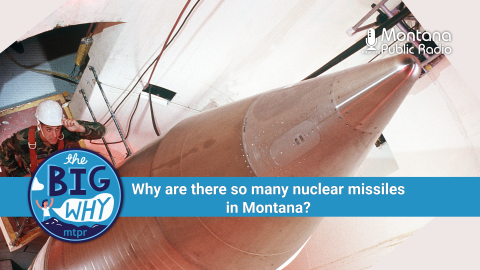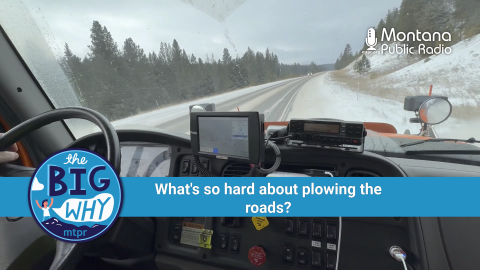Answers to your questions — big or small — about anything under the Big Sky.

The Big Why (get it?) is part of MTPR’s commitment to community-led journalism, telling the diverse stories of Montanans like you.
Join us in this collaborative! Ask your questions about anything under the Big Sky and we’ll help dig up the answers.
No question is too big or too small for the Big Why. Let's see what we can discover together!
Join us in this collaborative! Ask your questions about anything under the Big Sky and we’ll help dig up the answers.
No question is too big or too small for the Big Why. Let's see what we can discover together!
When it comes to winter driving, everyone wants their route clear and dry, and they want it done quickly. Why don't the plows come sooner or more often? Why don't they drop more salt or deicer? Why not get more drivers on the road? Tag along as a Montana snowplow driver prepares for a big winter storm and find out more about the logistical, environmental and technical challenges that come with keeping the roads clear of snow.
Listener favorites
-
A Helena listener had a long-simmering curiosity about a relic of Montana history that still sits just across the Beaverhead River from Twin Bridges: The old Montana State Orphanage built in 1894. We took a look around with one of the previous residents. Join us for the tour. This episode was first released September 27, 2023.
-
Across Montana there are hundreds of nuclear missile silos and launch facilities hidden in plain sight. If you didn't know what you were looking for, you probably wouldn't know what they were. So, why are there so many nuclear missile sites in Montana?
-
The Montana Constitution says "The state and each person shall maintain and improve a clean and healthful environment in Montana for present and future generations." How did that get included, and what does it mean for Montana? Learn more now on The Big Why
-
For this episode, we're trying to answer a question with potentially cosmic implications: Flying saucers. Lights in the sky. Montana is a hotspot for UFO sightings. Today, Montana Public Radio reporter Edward O'Brien is tackling the question: Why are reports of UFOs so common in Montana?
-
A flag's primary purpose is to be recognized from a distance. That means few colors, no lettering and a clear distinction from other flags. Ideally, it should be simple enough for a child to draw it from memory. So, how did Montana end up with such a complicated flag? Learn more in this episode of The Big Why.
-
When it comes to winter driving, everyone wants their route clear and dry, and they want it done quickly. Why don't the plows come sooner or more often? Why don't they drop more salt or deicer? Why not get more drivers on the road? Tag along as a Montana snowplow driver prepares for a big winter storm and find out more about the logistical, environmental and technical challenges that come with keeping the roads clear of snow.
Your questions answered
-
Everywhere you look in Montana, there are places to gamble. Odds are good you've seen machines in bars, liquor stores and of course, gas stations. How did Montana end up with so many "casinos," and what does it have to do with bingo? The only sure bet is that The Big Why team has the answers.
-
This week on The Big Why, we’re exploring Montana’s 56 counties. A listener from Billings wants to know how they got their shapes. Finding the answer led MTPR's Austin Amestoy down a rabbit hole where he found a saga of boom and bust, backroom dealing and an unlikely folk hero.
-
This week: A second edition of "The Little Why," where we tackle questions from our younger listeners. Saddle up, grab the reins and ride along with us as we learn about wild horses in Montana.
-
The word "wildfire" often conjures dramatic images of walls of flame, charred landscapes and one particularly famous photo of elk in a river, surrounded by flames. So, how do wildlife fare during these big fires? This week on The Big Why, a listener asks, why we don't get any statistics on wildlife that die in wildfires.























